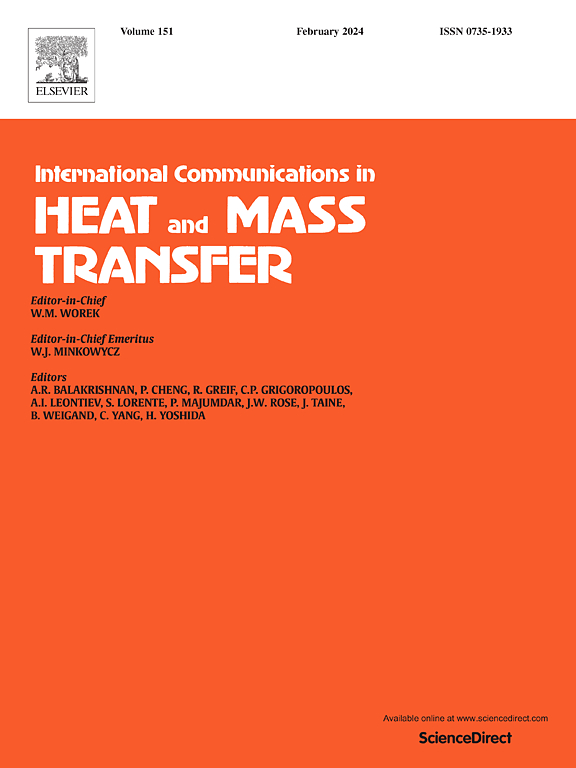通过手性和功能化优化氮化硼/环氧复合材料界面热阻:分子动力学方法
IF 6.4
2区 工程技术
Q1 MECHANICS
International Communications in Heat and Mass Transfer
Pub Date : 2025-05-31
DOI:10.1016/j.icheatmasstransfer.2025.109148
引用次数: 0
摘要
随着现代电子器件功率密度的增加,有效的热管理对于保持性能和可靠性至关重要。环氧树脂(EP)由于其优异的机械性能和电绝缘性而广泛应用于电子封装,但其固有的低导热性限制了其在高热流密度环境中的有效性。甘氨酸(NH2-CH2-COOH)功能化六方氮化硼纳米片(BNNS)作为填料有望解决这一问题。然而,BNNS边缘手性和功能化对界面热阻(ITR)的影响尚未得到充分的研究。在这项研究中,我们采用非平衡分子动力学模拟系统地研究了扶手椅和之字形BNNS结构以及甘氨酸功能化对BNNS/EP复合材料中ITR的影响。我们的研究结果表明,与之字形BNNS相比,扶手型BNNS显著降低了ITR,并且22.2%的甘氨酸功能化率导致ITR大幅降低约70%。对态的振动密度、均方位移和界面结合能的详细分析提供了对控制声子在界面上输运的机制的进一步了解。本研究建立了设计高导热复合材料的理论框架,并提供了一种通过优化BNNS手性和功能化来最小化ITR的新策略。本文章由计算机程序翻译,如有差异,请以英文原文为准。
Optimization of interfacial thermal resistance in boron nitride/epoxy composites through chirality and functionalization: A molecular dynamics approach
With the increasing power density of modern electronic devices, effective thermal management is crucial for maintaining performance and reliability. Epoxy resins (EP), widely used in electronic packaging due to their excellent mechanical properties and electrical insulation, suffer from inherently low thermal conductivity, which limits their effectiveness in high heat flux environments. Incorporating glycine (NH2-CH2-COOH)-functionalized hexagonal boron nitride nanosheets (BNNS) as fillers has shown promise in addressing this limitation. However, the effect of BNNS edge chirality and functionalization on interfacial thermal resistance (ITR) remains insufficiently explored. In this study, we employed non-equilibrium molecular dynamics simulations to systematically investigate the influence of armchair and zigzag BNNS structures, as well as glycine functionalization, on the ITR in BNNS/EP composites. Our results indicate that armchair BNNS significantly reduces ITR compared to zigzag BNNS, and that a glycine functionalization rate of 22.2 % leads to a substantial ITR reduction of approximately 70 %. Detailed analyses of the vibrational density of states, mean square displacement, and interfacial binding energy provide further insight into the mechanisms governing phonon transport at the interface. This work establishes a theoretical framework for designing high thermal conductivity composites and offers a novel strategy to minimize ITR by optimizing BNNS chirality and functionalization.
求助全文
通过发布文献求助,成功后即可免费获取论文全文。
去求助
来源期刊
CiteScore
11.00
自引率
10.00%
发文量
648
审稿时长
32 days
期刊介绍:
International Communications in Heat and Mass Transfer serves as a world forum for the rapid dissemination of new ideas, new measurement techniques, preliminary findings of ongoing investigations, discussions, and criticisms in the field of heat and mass transfer. Two types of manuscript will be considered for publication: communications (short reports of new work or discussions of work which has already been published) and summaries (abstracts of reports, theses or manuscripts which are too long for publication in full). Together with its companion publication, International Journal of Heat and Mass Transfer, with which it shares the same Board of Editors, this journal is read by research workers and engineers throughout the world.

 求助内容:
求助内容: 应助结果提醒方式:
应助结果提醒方式:


